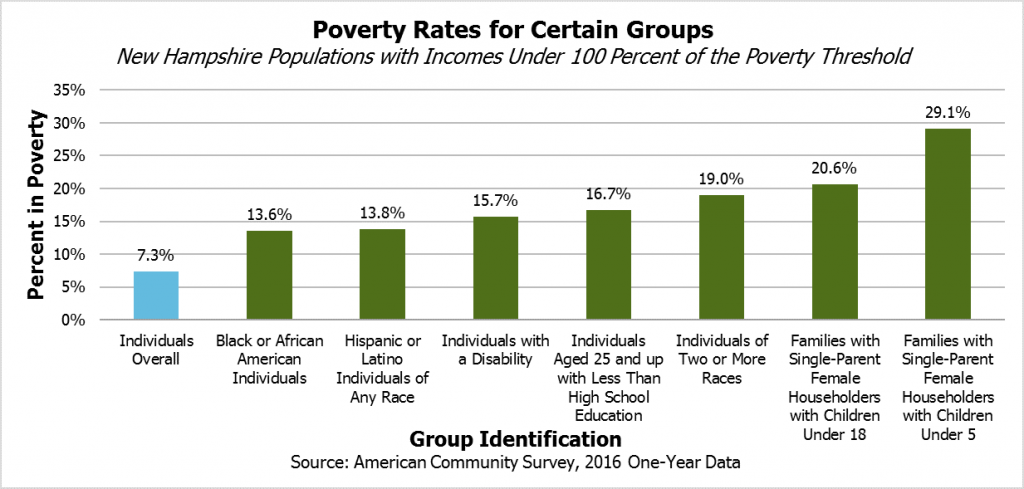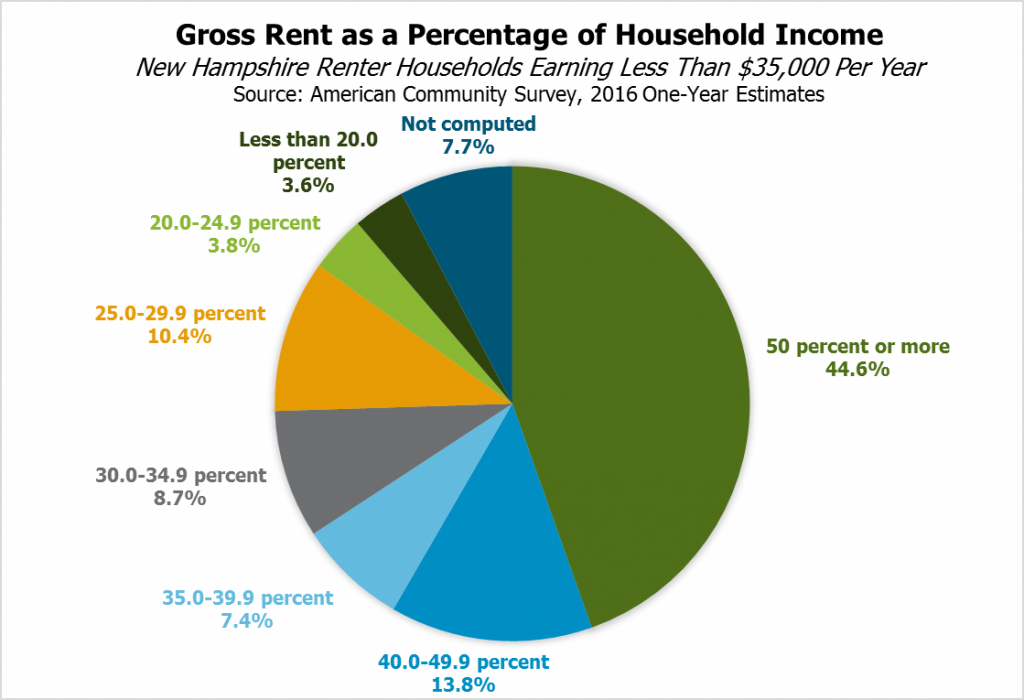The Census Bureau released the one-year estimates for 2016 population characteristics based on the American Community Survey on September 14, showing poverty and unemployment in New Hampshire continue to decline in the wake of the Great Recession, but some groups are still struggling more than others.
Household Income
The data show the economy continues to recover, lowering the overall statewide poverty rate but leaving certain groups with limited gains and means. About four percent of New Hampshire’s households, or approximately 20,826 households, earned less than $10,000 in income and benefits in 2016; the percentage was unchanged from the 2015 one-year estimates. The number of households with less than $35,000 in income and benefits remained at about 23 percent of all New Hampshire households, with approximately 117,665 households collecting less than $35,000 in income and benefits in 2016. Within this population, there was some upward shifting; more households in this group made between $25,000 and under $35,000 than in 2015, and less made between $15,000 and under $25,000. However, people living in these households, which account for more than one in five in the state, remain well below New Hampshire’s median estimated household income of $70,936.
Approximately 80.4 percent of the state’s households had earnings, and 33.2 percent had Social Security income. Mean Social Security income for households receiving it was $20,217. Retirement income went to approximately 19.3 percent of households and averaged an estimated $26,198. Supplemental Security Income went to 5.0 percent of households and averaged $11,286. About 2.1 percent of households received cash public assistance income in New Hampshire, a statistically significant drop from 2015 data levels of 3.2 percent. Average cash public assistance income was $2,615 over the year. About 7.1 percent of households received Food Stamp benefits.
Poverty
The poverty rate, or the number of people below the poverty threshold, dropped a statistically significant amount between 2015 and 2016, from 8.2 percent to 7.3 percent, with an estimated 94,289 Granite Staters in poverty in 2016. The poverty threshold used by the Census Bureau for income in the twelve months preceding July 2016 is $12,391 for an individual under 65 years of age and $19,171 for a family of three with one child. About 3.2 percent of the population had incomes below half of the federal poverty threshold. Ten percent of the population, or about 128,975 people, had incomes less than 125 percent of the poverty threshold, and an estimated 251,947 state residents had incomes below 200 percent.
Females were more likely than males to live in poverty, with estimated poverty rates of 8.1 percent and 6.5 percent, respectively. Those 65 years of age or older were less likely to be in poverty, with an estimated poverty rate of 4.6 percent (a statistically significant drop from the 2015 data’s 6.1 percent), than those under 18 years old, who faced a poverty rate of 7.9 percent (a significant drop from 2015’s estimated rate of 10.7 percent).
People identified has having a disability were more likely to live in poverty, with an estimated poverty rate of 15.7 percent, than those without a disability, with a group poverty rate of 6.1 percent. Single-parent families headed by females, which included an estimated 155,419 New Hampshire residents, had a much higher poverty rate (14.1 percent) than for all families (4.0 percent). Of families with single-parent female householders and related children under 18 years old, the poverty rate is estimated to be 20.6 percent, which dropped from the 2015 data; for families such as these but specifically with children under 5 years old, the poverty rate is statistically unchanged at an estimated 29.1 percent.
Poverty rates were highest for those identifying as two or more races, which included an estimated 26,367 Granite Staters, at 19.0 percent, and 13.6 percent for those identifying as Black or African American alone, who comprised an estimated 14,483 people in New Hampshire. The poverty rate was estimated to be lowest for those identifying as White alone, at 6.9 percent. Those of any race identifying Hispanic or Latino origin, a separate category from the racial breakdowns in Census Bureau data, had an estimated poverty rate of 13.8 percent, while those identifying as White alone and not Hispanic or Latino had a 6.7 percent poverty rate.
The poverty rate for those 25 years and older with a bachelor’s degree or higher was estimated to be 3.2 percent for 2016, 8.1 percent for the estimated 250,483 Granite Staters who were at least 25 and had graduated high school only or achieved equivalent status without any college, and 16.7 percent for the estimated 64,302 state residents who had less education than a high school graduate and were at least 25 years old.
To learn more about the shortcomings of the poverty threshold in New Hampshire, see NHFPI’s Taking the Measure of Need in the Granite State report.
Housing
For renter households with less than $10,000 a year in income, gross rent exceeded 50 percent of household income for nearly two out of every three households (65.6 percent). About 59.2 percent of renter households earning between $10,000 and just under $20,000 still see 50 percent or more of their income going to rent, and 25.8 percent of those renter households earning between $20,000 and just under $35,000 devote 50 percent or more of their income to rent. This compares to only 2.5 percent of households earning $50,000 to just under $75,000 that devote 50 percent or more of their incomes to rent. In total, 44.6 percent of renter households making less than $35,000 per year paid 50 percent or more of their incomes to rent in New Hampshire, and nearly three in every four renter households (74.5 percent) in this income group paid more than 30 percent of their incomes to rent.
Data Details and Future Releases
The data are based on surveys; as such, some characteristics cannot be estimated for everyone in the state population, and each estimate has a certain margin of error. The Census Bureau plans to release five-year estimates, which will provide data at the municipal level, in December.


